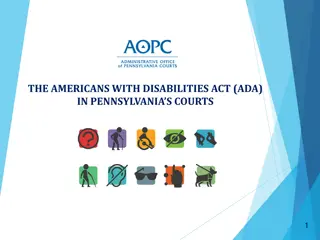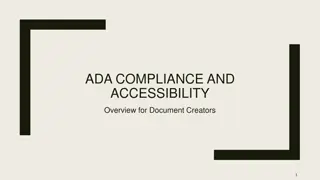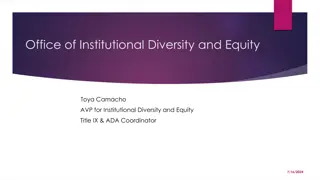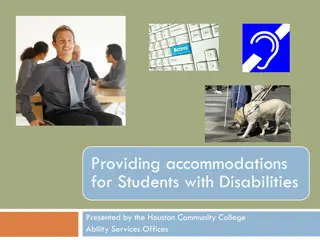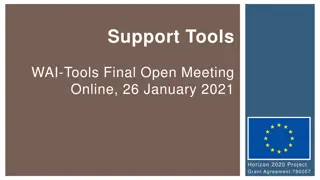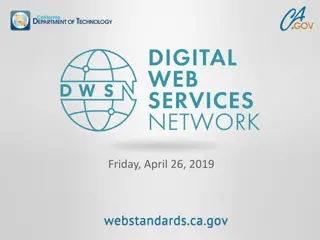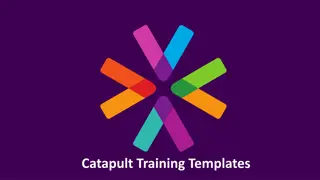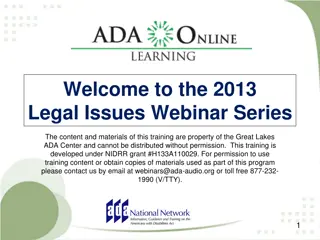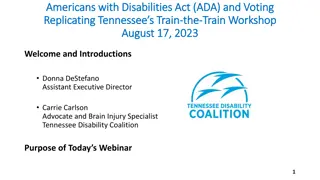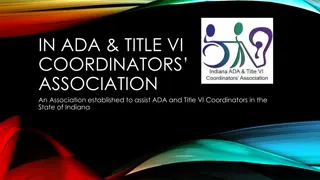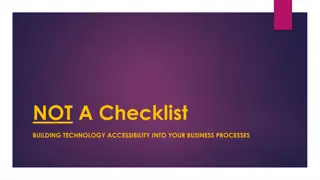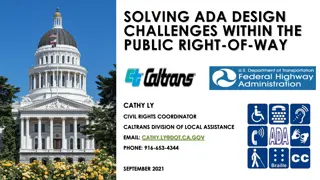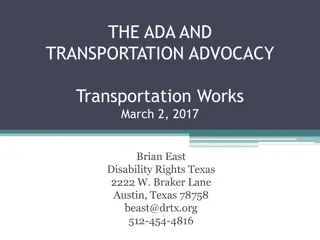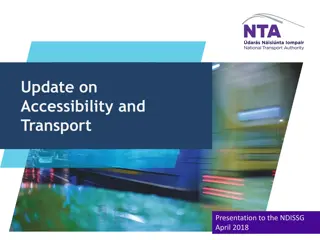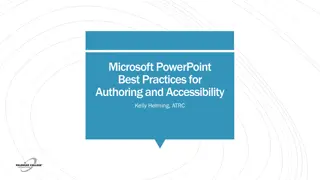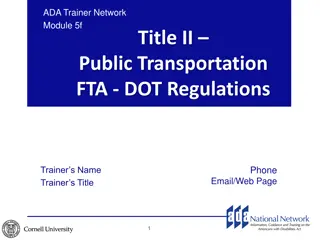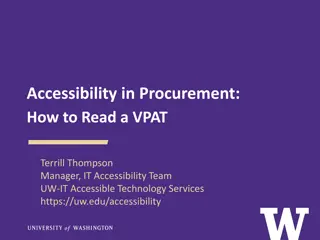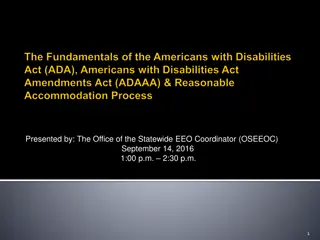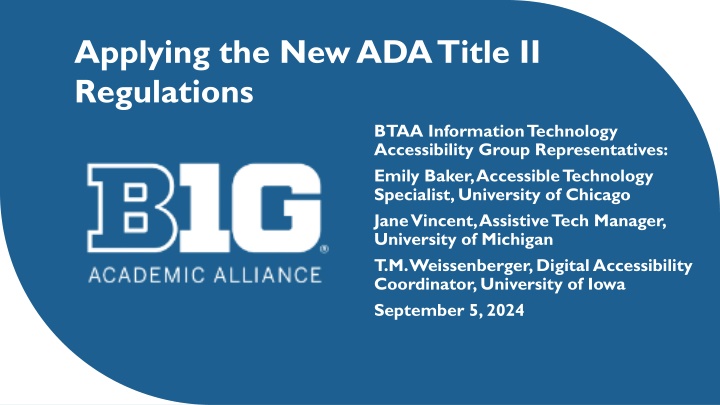
Applying New ADA Title II Regulations - BTAA Information Technology Accessibility Group
In this event, representatives discuss Digital Accessibility, Web Content Accessibility Guidelines (WCAG), and more. Learn about integrative, adaptable, intentional accessibility practices. Discover the importance of POUR principles for creating accessible digital content.
Download Presentation

Please find below an Image/Link to download the presentation.
The content on the website is provided AS IS for your information and personal use only. It may not be sold, licensed, or shared on other websites without obtaining consent from the author. If you encounter any issues during the download, it is possible that the publisher has removed the file from their server.
You are allowed to download the files provided on this website for personal or commercial use, subject to the condition that they are used lawfully. All files are the property of their respective owners.
The content on the website is provided AS IS for your information and personal use only. It may not be sold, licensed, or shared on other websites without obtaining consent from the author.
E N D
Presentation Transcript
Applying the New ADA Title II Regulations BTAA Information Technology Accessibility Group Representatives: Emily Baker, Accessible Technology Specialist, University of Chicago Jane Vincent, Assistive Tech Manager, University of Michigan T.M. Weissenberger, Digital Accessibility Coordinator, University of Iowa September 5, 2024
Use Zoom CC button, or 1Cap for human-generated captions Slides will be available electronically We will monitor the chat and answer as many questions as possible during our Q&A at the end. Any questions submitted via our Google form will be answered via Email after the session. Housekeeping Presentation will be recorded except for the Q&A session.
Prologue Title II Success Framework Agenda Case Studies Next Steps Q&A
Introductions Jane Vincent she/her T.M. Weissenberger he/him Emily Baker she/her 35 Years Experience Current ITAG Co-Chair 38 Years Experience Current ITAG Co-Chair 26 Years Experience Past ITAG Co-Chair
BTAA Accessibility Webinars Americans with Disabilities Act (ADA Coordinators), June 28 BTAA Library Accessibility Group, August 27 BTAA Information Technology Accessibility Group, September 5 BTAA Q&A Panel, TBD
What is Digital Accessibility? Equivalent: integration, independence, timeliness, ease, effectiveness One or more of these is often overlooked by providers Adaptable:usable by anyone the way they need and prefer to use it Tech providers often don't understand alternate modes of access Intentional: proactive, user-centered, continuous improvement Accessibility is often an afterthought, oversight, or assumption POUR: Perceivable, Operable, Understandable, Robust
Web Content Accessibility Guidelines (WCAG) Not complicated: objective, testable guidelines and success criteria for creating accessible digital content Not just for the web: WCAG techniques apply across a spectrum of document content and formats Not just rules: training and learning resources, videos, demos, testing tools, quick reference Not a checklist, a methodology; not a mandate, a means Learn more: Understanding the Web Content Accessibility Guidelines Information Session
Were here to help Build on PAST work Use the PRESENT to prepare Keep FUTURE goals in mind Title II Success Framework
Were Here To Help! Each BTAA school already has representatives within groups such as ITAG, Library Accessibility, Learning Technology Leaders, ADA Coordinators, etc. Accessibility-focused BTAA groups work internally and with each other to share best practices, brainstorm solutions, and provide institution-wide support If you need any session materials in alternate formats, please email jbvincen@umich.edu
Build on PAST Work Who is already taking responsibility for accessibility on your campus? What resources are already available? How current are your accessibility policies and guidelines? List of primary accessibility websites and policies for all BTAA schools
Use the PRESENT to Prepare Start Now don t wait for a perfect solution Familiarize yourself with the The ADA.gov Fact Sheet Create a strategy: remove, replace, remediate, create o The August BTAA Library presentation has good info on this Provide high-quality tools for development and QA testing Build campus-wide awareness and aptitude
Keep FUTURE Goals in Mind Shift left - Include accessibility at the beginning of any project Make ongoing compliance easy and routine Provide ongoing metrics Keep accessibility specialists involved
In-house efforts University of Michigan Case Studies Procurement The Ohio State University
University of Michigan - Facilities and Operations Report and analysis on the efforts of Facilities and Operations Information Services, an in-house working unit , to assess and transform Electronic and Information Technology accessibility to meet updated regulations. Jonas Daunoravicius - DevOps Manager Sean Lindblade - Information Integration Program Manager Stephanie Rosen ITS Accessibility Assistant Director
Our Journey and Charge Facilities and Operations (F&O) Accessibility o 2018: FOIS Web Content Accessibility Guidelines June 2022: U-M SPG 601.20 policy October 2022: Digital Accessibility Project kickoff
Our Initial Objectives Review and Inventory Review existing F&O and U-M accessibility policies and procedures Canvas the greater university ecosystem to advance developing digital accessibility within F&O Gather inventory of all Electronic and Information Technology (EIT) relevant to SPG 601.20 Generate inventory with initial evaluation presented to sponsors Evaluate inventory - Deliver Accessibility Risk Assessment Evaluate projected scope of work and deliver recommendations to reach compliance
Our Initial Activities Departmental on-site presentations / training Hands-On with documents and accessibility tools Crowdsourcing Workshop Generate Long Term Guidance Policies, procedures, and priorities
Things We Learned So Far Defining an EIT is a bit more complicated than we thought Realized that one application can produce more than one EIT assessment, so we needed to create a range of categories to help define our EIT inventory and guide our assessment efforts The application itself, o The documents and reports it produces, o and the notifications and communications it generates o
Things We Didn't See Coming The need for flexibility and course corrections The recent DOJ ruling upended our proposed document solution Ongoing (re)assessment of quickly shifting palette of tools and technology (AI) Transitioning from a Project to a Process Our tracking spreadsheet needs to become a database to meet unit-specific and centralized needs Making the valuable inventory data available for other purposes New Challenges
Current and Future Work - UMich ITS Interpretation - making sense of updates regs Internal documentation and sharing Prioritization - making plans and doing work Course content accessibility Web and applications accessibility Procurement Learning - building on past foundation and findings Structures for resources, collaboration, and support Challenges and opportunities
External Partnership => Accessibility (1) Misty Lenhart, Ohio State University OSU & External Evaluation Identified a need to quickly evaluate, remediate, and retest a set of websites (including documents and videos) Received funding with a 4-month time frame Selected one of our evaluation vendors and a captioning vendor previously selected thru RFP; selected the PDF vendor widely in use at Ohio State
External Partnership => Accessibility (2) Vendor evaluation preparation: Worked with us to determine strategy, timeline, and expectations Created an evaluation request form based on our website inventory to collect use cases, components, and landing pages for testing Provided training to impacted units on how to use their portal Created a dashboard for us to monitor progress Participated in our weekly office hour to answer any questions from units Had a 15-minute daily stand-up with us to work through questions or concerns Had a 30-minute weekly meeting with two of our accessibility experts
External Partnership => Accessibility (3) Vendors for PDF and video remediation preparation: Set up their portals to capture submissions by unit Worked with us to create training for units to submit for remediation and retrieve remediated product Sent us regular updates on work completed
External Partnership => Accessibility (4) Lessons Learned: As an institution, determine what compliance means and plan on how to show progress towards compliance. This is a journey! Ensure funding is provided for all components of the work. Project management oversight is KEY both in working with the vendors and university units. Clearly define what your requirements are for evaluation/remediation and ensure the vendors you choose will work to your specifications. For web evaluation, factor in multiple cycles of remediation as issues may not be fully remediated and/or may cause new issues. Plan for a considerable amount of time providing guidance and support to your units.
External Partnership => Accessibility (5) Thank you. Misty Lenhart Digital Accessibility Services The Ohio State University das@osu.edu
Collective pressure on vendors Accessibility as an ongoing process Taking Next Steps Across the BTAA
Collective Pressure on Vendors Consistent messaging from BTAA members is likely to be more effective than individual requests BTAA ITAG Vendor Cookbook Opportunities to share information about various products
Accessibility as an Ongoing Process Take advantage of SME s Track metrics to demonstrate ongoing progress Stay current on clarifications and updates to federal and other requirements Share expertise and best practices across the BTAA
Emily emly@uchicago.edu Jane jbvincen@umich.edu Thank You! T.M. todd-weissenberger@uiowa.edu ITAG Website

